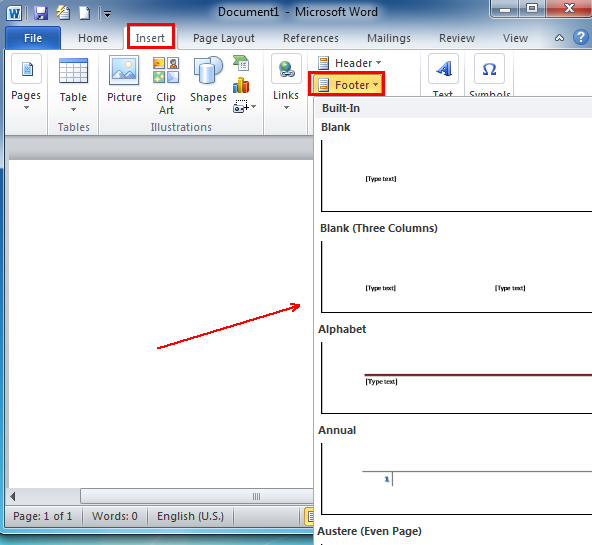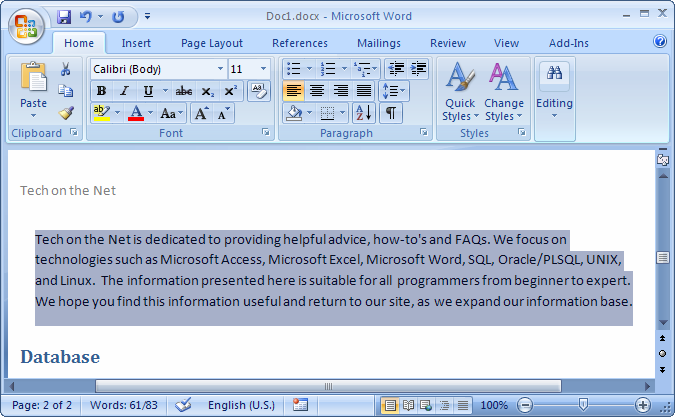If you need to work with Microsoft Word on a regular basis, you might have felt that archiving a large number of your documents is rather difficult. Generally, the easiest way of finding files is by looking through their file names. It can be even handier to include the filename on the document body itself, generally in the header or the footer. Here is how you can automatically insert the file name of your document in its header or footer.
- How To Add Footer In Word 2016
- How To Add A Header On Word
- How To Add Footer In Wordpress
- How To Add Footer In Word With Document Path
In the header or footer area, select the page number. Use the Tab key to position the page number left, center, or right. If the number is flush left, press Tab once for center, and twice for right. To go back, press Backspace until in position. To add a footer, click the Insert tab to access the footer button. Word offers a number of predefined footer templates that you can start with and customize as needed. Word guides you in placing the bits of information in different locations in your footer.
How To Add Footer In Word 2016
You can basically add the filename to any section of your document but adding it to the header or the footer will enable you to make it appear on all pages throughout the document. To edit your header or footer, go to Insert>Edit Header or Insert>Edit Footer respectively. You’ll now see that the design tab at the top is highlighted. From the ribbon under the Header and Footer tab, click on the Quick Parts Dropdown. Next, choose the “Field” Option. In the Field Names section, scroll down and select Filename. You’ll now get options to insert the FileName in UpperCase, LowerCase, Middle Case etc. If need be, you can also add the path to the file along with the filename by choosing the “add path to filename” option. Once you’re done, click OK. Now the FileName of the document will automatically appear on all pages of your document.

Now what If you want to do this for all future documents that you’ll be working on? Modifying the footer and adding the custom field for the filename for every document can be a bit nagging. But don’t worry; by modifying the default template you can automatically add filenames to all the documents that you’ll create in the future.
Open the default template named Normal.dotm(or Normal.dotx for older version of Word). In the File>Open dialogue box, select “Word Macro-Enabled Templates” from the filetype dropdown. Now, select the Microsoft Word Templates folder from the navigation menu at the left. You’ll now see a normal.dotm file in the files section. Go ahead and open it. Now modify its footer the same way as above and to the filename. Finally save the template file. Once this is done, the filename will be automatically added to all Microsoft Word files that you’ll be creating in the future.
By J. Carlton Collins, CPAQ. I've created a Word document with multiple chapters, and I want to insert different headers and footers for each chapter. However, each time I create a new header, it changes my previous headers. What's the solution to creating different headers?
A. As a default in Word, all subsequent headers and footers link to the previous page's header and footer. To insert a new header or footer without altering the one you've already inserted, navigate to the bottom of the last page before your new header or footer, and from the Layout tab (or the Page Layout tab) select Breaks, Next Page as pictured below. This action will create a section break enabling you to apply different attributes (such as headers and footers, margin settings, page sizes, orientations, etc.) to one section of the document without affecting other sections.
How To Add A Header On Word
On the next page after the break, navigate to the header or footer area and double-click that area to make it editable (referred to as Design mode); this action also displays the header and footer toolbars. Next, select the existing header or footer and click the Link to Previous option (as circled below) to break the header or footer connection.

Once the link is broken, you can edit or change the new section's header or footer without affecting your previous headers or footers. Continue to insert Next Page breaks and then break the link connections for each subsequent chapter where you want different headers or footers to appear.
About the author

J. Carlton Collins (carlton@asaresearch.com) is a technology consultant, a CPE instructor, and a JofA contributing editor.
Note: Instructions for Microsoft Office in “Technology Q&A” refer to the 2007 through 2016 versions, unless otherwise specified.
How To Add Footer In Wordpress
Submit a question

How To Add Footer In Word With Document Path
Do you have technology questions for this column? Or, after reading an answer, do you have a better solution? Send them to jofatech@aicpa.org. We regret being unable to individually answer all submitted questions.
